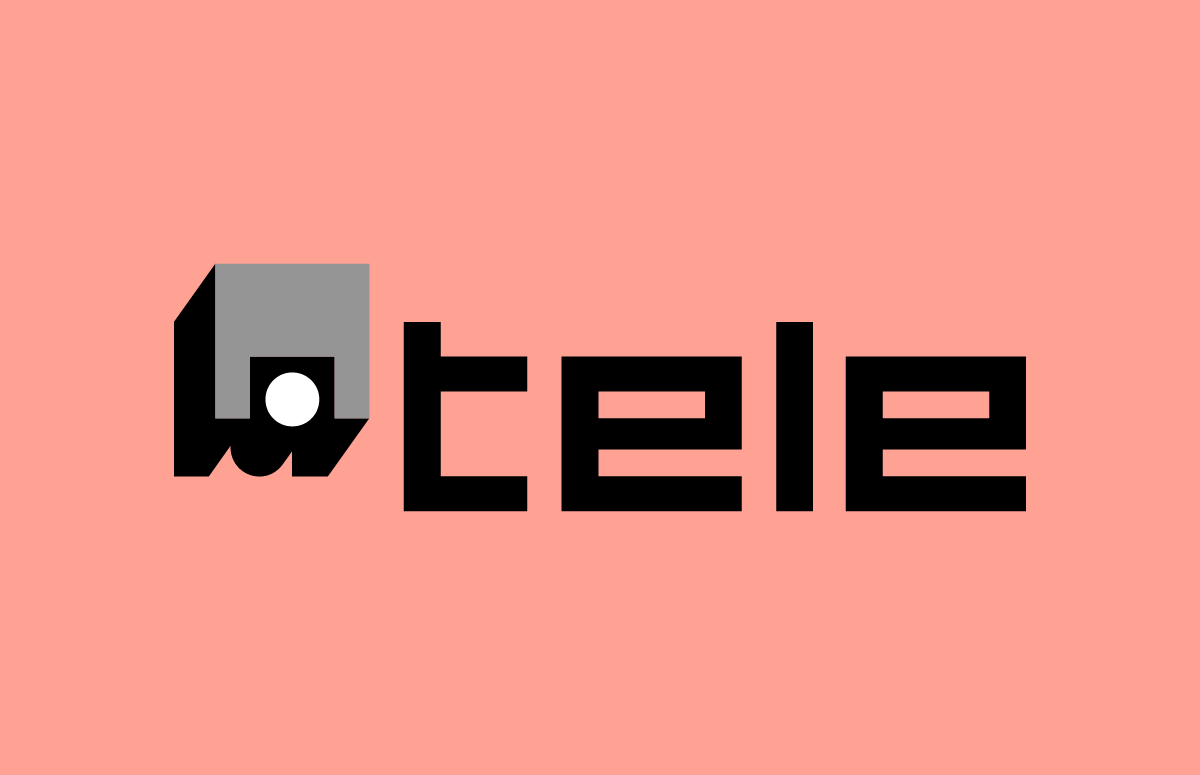Drowning in mass advertising? Exclusive study & experts reveal why effective advertising thrives on personalized channels
Read in this eBook:
Chapter 1: From mass advertising to personalised marketing
Every day, we're bombarded with advertising. This inundation has made people more sensitive to advertising messages, which in turn affects marketing strategies. The trend is shifting away from traditional mass advertising toward individualized and personalized approaches.
Today, consumers expect messages that reflect their needs and preferences. Marketers are challenged to develop approaches to build deeper connections with their target audience. The key lies in the art of not just marketing products, but creating unique experiences that address individual needs.
What do the statistics say?
However, not all forms of personalisation are welcome. A recent statistic shows that 60% of respondents feel that personalised advertising pushes them to buy certain products. A further 59% say they feel watched when they see personalised ads. (Source: Statista)
In contrast, studies show that personalisation increases customer engagement, open rates, and purchase activities, leading to up to 40% more revenue. (Source: McKinsey)
The conclusion drawn from this can only be that marketers need to find the right balance between the channel, timing, and the right content.
In the following chapters, we'll look at the importance of email as a marketing channel in this context. However, this is not about the traditional newsletters or mass emails, but about the individual emails that employees send to their customers on a daily basis.
In the upcoming chapters, you can expect:
-
An interview with marketing psychologist Sabrina Etter on the advertising flood we face today and the sales psychology principles marketers work with;
-
The results of our eye-tracking study, which sheds light on the effectiveness of email signatures;
-
How email signatures can be used as part of an ABM strategy;
-
Checklists, examples, and much more.
Enjoy reading!
Chapter 2 - Interview: How marketers reach their audience in the noisy world of advertising
Every day, our brains are challenged to process thousands of advertising messages. Experts estimate that the average person is exposed to between 5,000 and 13,000 messages a day.
It's becoming increasingly difficult for marketers to cut through this noise and reach their target audience.
We spoke to Sabrina Etter about this challenge.
About Sabrina Etter
Sabrina has a Master's degree in Psychology & Media Sciences. She consults with companies on psychology in marketing. She shows her clients how to integrate psychological triggers into their marketing strategy to increase customer loyalty and sales.
More and more advertising
We are bombarded with around 100,000 stimuli per second.
Sabrina explains: "Unlike in the past, we have a lot more information coming at us, but at the same time, our attention spans have decreased drastically."
Studies back this up. The attention span of Generation Z is only eight seconds, compared to twelve seconds for previous generations.
"The brain is very good at filtering information, so marketing and advertising has to be really convincing in the first second," Sabrina points out.
Studies show that we process 90 per cent of information unconsciously and only about 10 per cent consciously. This has an impact on the way we perceive advertising.
Sabrina explains: "People think of the brain as a thinking machine, but it works more like a filter.“
 People only process about 10% of the information consciously.
People only process about 10% of the information consciously.
Advertising underdog email
"Email is a constant in marketing, while the performance of other strategies fluctuates.
Email is a reliable advertising strategy because you can use psychological buying incentives very effectively. For example, our brains like order. Email can be very well structured to make it easier for the eye and brain to sort through the information.
You can use paragraphs and images, you can use colours, maybe even some emoticons. If I also have a personal message and talk about wishes and needs in the content, it can work well.
It is also interesting to look at buying behaviour via email. Studies have shown that email readers can be divided into three buying groups:
5% of readers buy immediately. This group has been looking for such a solution and is therefore ready to buy immediately.
75% don't even read the email and delete it immediately.
"The last group is the most interesting. 20% of recipients find the offer interesting, but the timing is not right."
“They are interested in staying in touch with the company and could be potential buyers in the future. I can reach this group again with further emails.“
"This should be kept in mind because it makes email a channel that is likely to work very well in the coming years."
Personal business email as an advertising channel?
An eye-tracking study by UX Labs of the University of Zadar and Mailtastic showed that banners in business emails are an effective advertising channel - without appearing too commercial.
On the contrary, participants in the study rated the banners positively and even preferred emails with banners to those without. From a marketing psychology perspective, Sabrina evaluates the results as follows:
"Your study is very much in line with previous eye-tracking studies. In general, we can assume that the gaze path is from top to bottom and from left to right. This means that when we read an email, we start at the top left and then move through the text in this pattern.
At the same time, studies show that images are looked at first and that images are usually looked at longer than text. If the text is clearly structured, with short sentences, and the image is below it, it works well. I even stay on the page longer because I want to read the banner at the end. If you then support it with colour, you can direct the eye even better."
You can see this very clearly in the eye-tracking recordings. The red dots show the fixation of the test person's gaze and the viewing path of the email.
![]()
Sabrina adds: "If I have short text and paragraphs and the reader immediately knows how long the email is, they will definitely look at the image at the end. Our brains process images faster and easier. We don't always feel like reading long paragraphs and making a cognitive effort. That's why we prefer images.“
"If I want to emphasise this even more, I include people in the banner. We humans always look at the face first and our attention goes there quickly."
This is also shown by the results of the eye-tracking study on the effect of email signature banners. Banners with faces are fixated significantly more often than the control banner without a face. This is shown in the heatmaps of the study.
![]()
Again, Sabrina has a few tips. "For example, if the direction of the person in the banner points to a CTA button, and the person is looking at it or even pointing at it, then our gaze automatically goes to that button.“
4 principles of sales psychology with examples
Sabrina explains that the most successful sales psychology principle today is social proof.
Social Proof:
Sabrina explains that the most successful sales psychology principle today is social proof.
"We like to trust other people when making decisions. We hope that others have already checked out the offer a bit better than we have, and then we go by their recommendations.
The best example of this is customer reviews. If I see that a product has 5,000 reviews with 4.5 stars, then as a consumer I know, OK, many others have tested this product before me, I can buy it.
Applied to services or the B2B sector, these are often references or industry-specific review platforms.“
The concept of social proof can also be applied to email signatures. For example, a quote from a customer can build trust in the email contact. As the eye-tracking study shows, people's gaze is particularly directed to the banner when a person is featured in the banner.

Chapter 3 - Eye tracking study: The impact of email signatures on marketing
On average, an office worker sends 40 emails per day. But what if each of these emails could be more than just a part of daily communication, but also a potential marketing channel?
That's where an email signature banner from an employee could significantly boost clicks and impressions for marketing campaigns. But how are additional visual elements like a banner in the email signature perceived?
We speak with Mate Juric, Assistant Professor at the UX Lab of the University of Zadar, about the findings and how marketers can leverage signatures to support their marketing campaigns.
![]()
“Our research indicates that well-designed banners enhance the email experience and overall interaction, without detracting from the original email content.”
Mate Juric, Assistant Professor at the UX Lab, University of Zadar
What influence do signature banners have on the perception of an email?
“Based on the eye-tracking data, it's interesting to note that there was no reduction in the reading time of the email text. Participants still read the entire text of the email and then viewed the banner.
So the banner is not seen as a distraction, but as useful additional information. Participants also said in surveys that the banners were appealing and trustworthy," says Mate.
For marketers, this presents an untapped opportunity, as they can leverage this positive attitude towards banners by offering engaging and contextually relevant content."
How should banners be designed to get clicks?
Our data show clear preferences regarding banner design. Pastel colors were preferred over neon, and darker backgrounds over lighter ones. Banners featuring faces and clear call-to-action buttons achieved higher click-through rates.
Interestingly, dynamic (GIF) banners and static banners were clicked on equally. However, the number of eye fixations was significantly higher for dynamic banners.“
At this point, it is important for marketers to consider the objectives of their campaigns:
"GIF banners attract more attention but not necessarily more clicks. They are excellent for awareness campaigns, but if the goal of a campaign is to increase clicks and conversions, marketers should focus on other elements when designing banners."
Tips for marketers
"Beyond just designing banners, marketers should always keep the context of their banner campaign in mind. This encompasses two crucial aspects:
"It's important for the content of the banner to align with the content of the email and the sender's message. Therefore, the banner should not only be visually appealing but also fit into the overall context of the email."
Another important aspect is considering the buying phase the customer is in. Depending on whether the customer is in the initial phase of decision-making or already in the final purchase consideration, banners can be designed differently. Targeted messaging that addresses the needs and questions of the customer increases the likelihood of a positive response.
Mate explains: “The successful integration of banners into email signatures requires not only aesthetic design but also strategic alignment.“
“By considering the contextual relevance, marketers ensure that their banners not only stand out but effectively reach and influence the target audience.“
Chapter 4 - Checklist: Designing Effective Email Signature Banners
How do marketers create an effective and professional banner? Here's a brief checklist featuring insights from our eye-tracking study and practical tips from Ognen Bojkovski, Senior Design Manager at Cognism & Mailtastic.
✅ Define campaign objectives
Consider the campaign goals:
- GIF banners are a good choice for awareness campaigns.
- Static banners are more likely to be clicked and converted.
While dynamic content like GIF banners captured more attention than static banners, the study revealed a surprising 50/50 distribution in clicks. For campaigns with click and conversion goals, this suggests that static banners with a clear CTA are better suited.
![]()
✅ Color scheme
Use coloured backgrounds contrasting strongly with white to help the banner stand out from the email background.
Analysis of the study results shows that dark banners were clicked significantly more often.


✅ Images
Incorporate images of people, especially focusing on faces, to draw attention to the banner.
Ideally, the person's gaze should be directed towards the main message or a call-to-action.
“When we want to convey emotions, the best design element is a photo of people with a specific facial expression or expressing an emotion.
If we want to show statistics, numbers, before-after results, a simple infographic is best suited.
So, it all depends on what kind of information we want to convey to the email recipient.”

✅ Call-To-Actions (CTAs)
Use clear and concise calls to action in the form of buttons, e.g., "Sign Up Now".
CTAs communicate what the reader can expect after clicking on the banner, thus increasing click-through rates.

✅ Clear layout
Keep the design simple and clear so that the reader can quickly grasp the message. Ognen advises:
"The main message of the banner - whether it's the title, an illustration, a photo or any other design element - should be in the foreground. All other elements should be secondary in the design. The reader must be able to tell at a glance what it's about and who the company is.“

✅ Brand compliance
Pay attention to your corporate design, especially when designing banners, to create a strong brand identity in each email. Use brand elements such as:
- Logos
- Colours
- Fonts
- Imagery
- Graphics
"It is important to apply brand guidelines correctly in order for a company to have high brand recognition.
Therefore, banners should use the company logo, the font, a good colour balance from the company's colour palette and possibly other design elements.
Follow the guidelines most of the time, but occasionally be creative: consciously break the rules to keep the design fresh and interesting."
✅ Make it relevant
Contextually tailor the content of the banner to the specific email or the recipient's interests. For example, showcase a case study in your banner that aligns with your recipient's industry.
Do's and don'ts of designing banners

Chapter 5 - Banner examples for your email signature
Here are some examples of how you can integrate email signature banners into your marketing campaigns.👇
Product and sales campaigns
Promote special offers, discounts or products with email signature banners. Your employees can share special offers with every email they send, highlighting your product or new features. Whether it's up-selling, cross-selling or dedicated customer promotions, you can send the right content to the right audience at the right time.
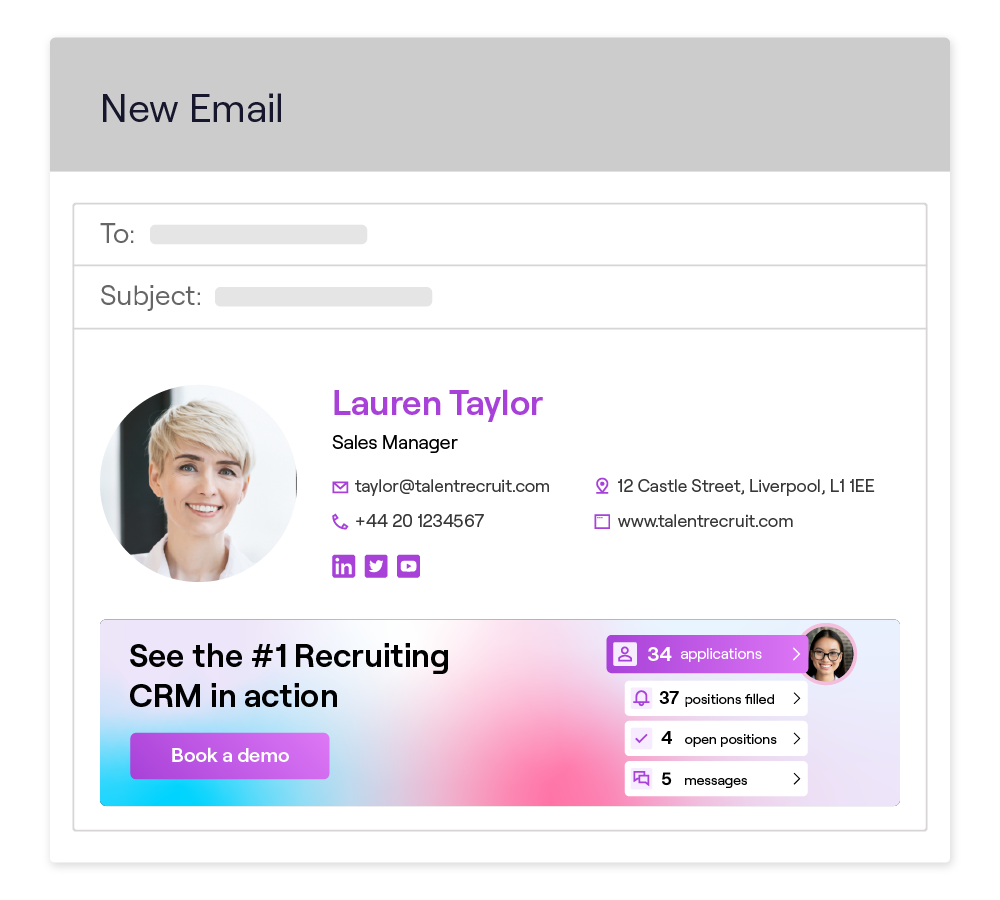
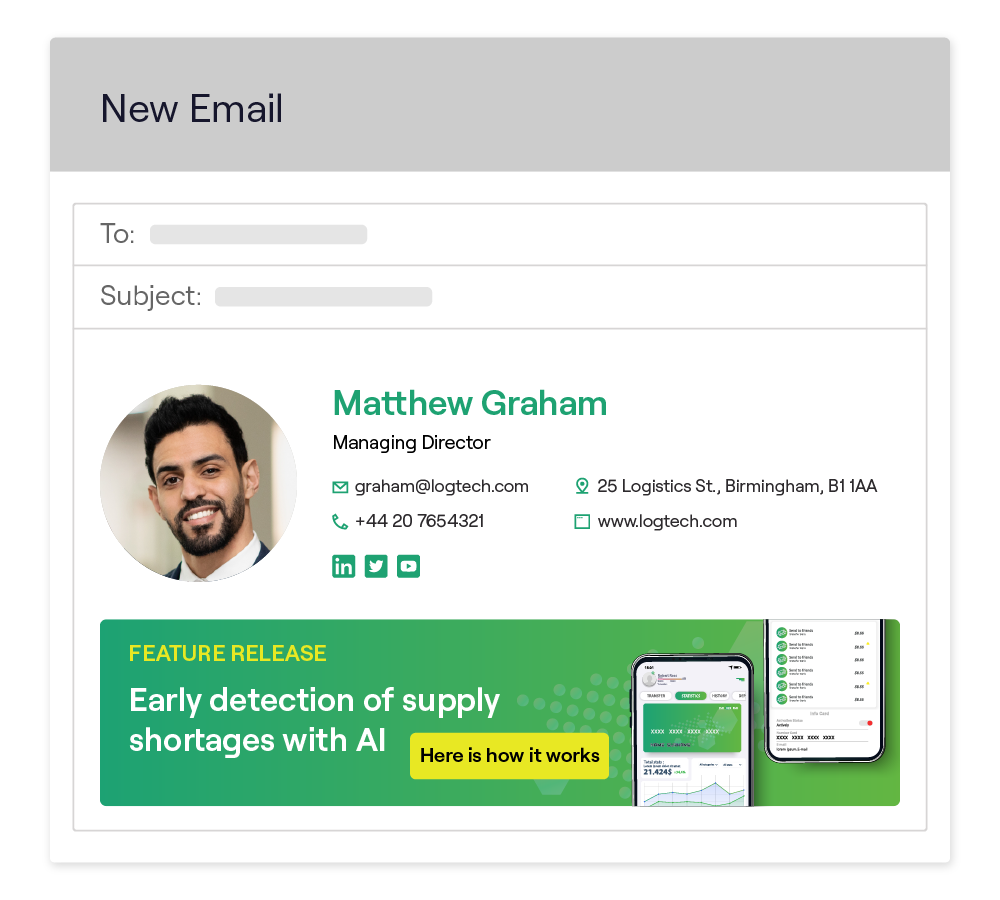
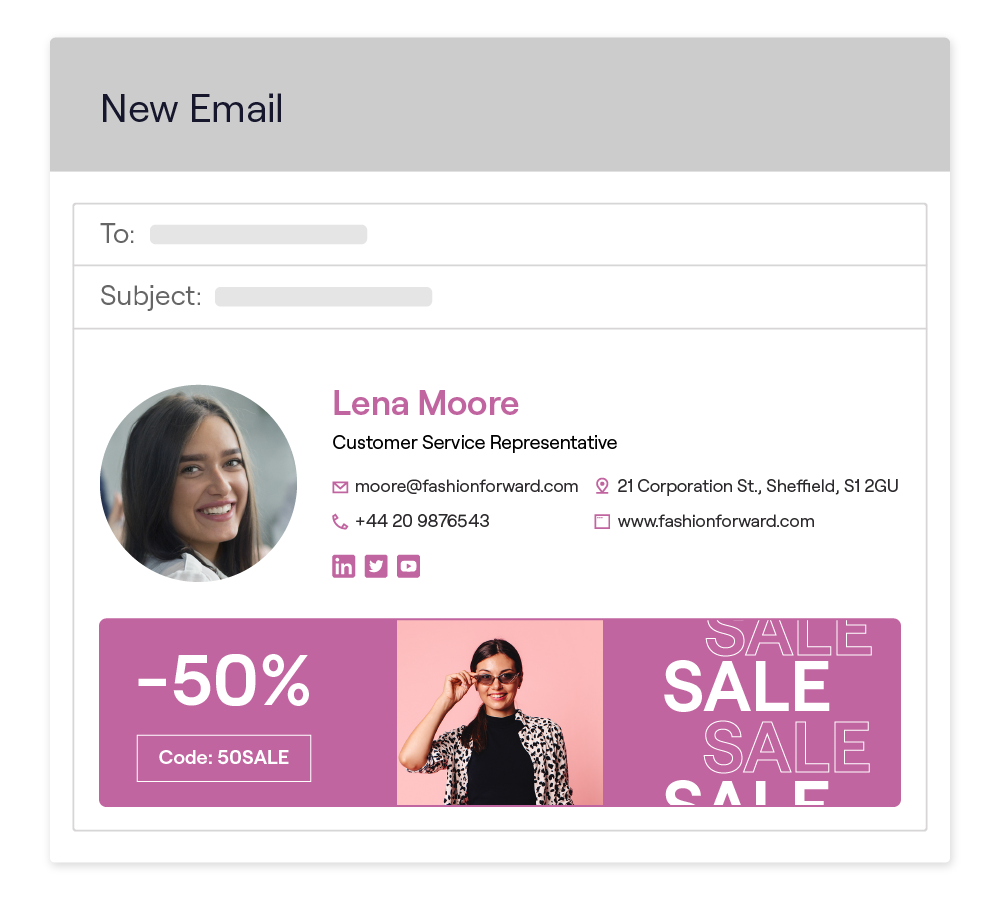
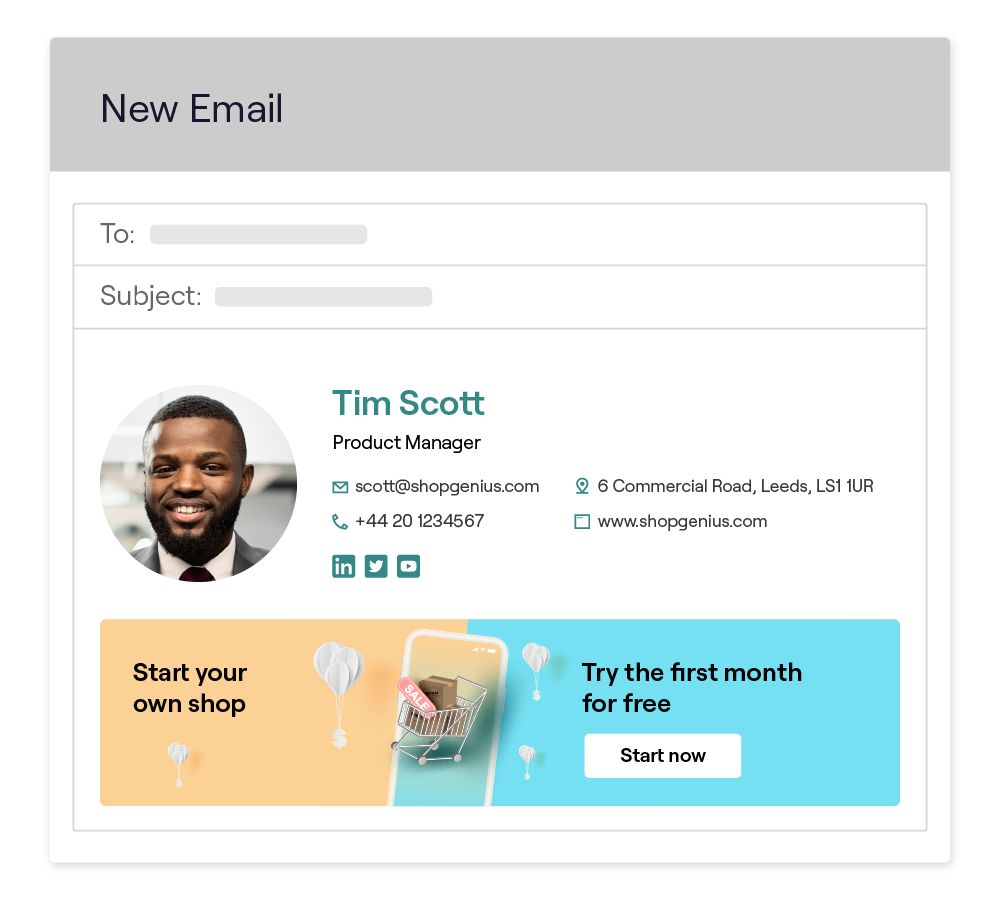
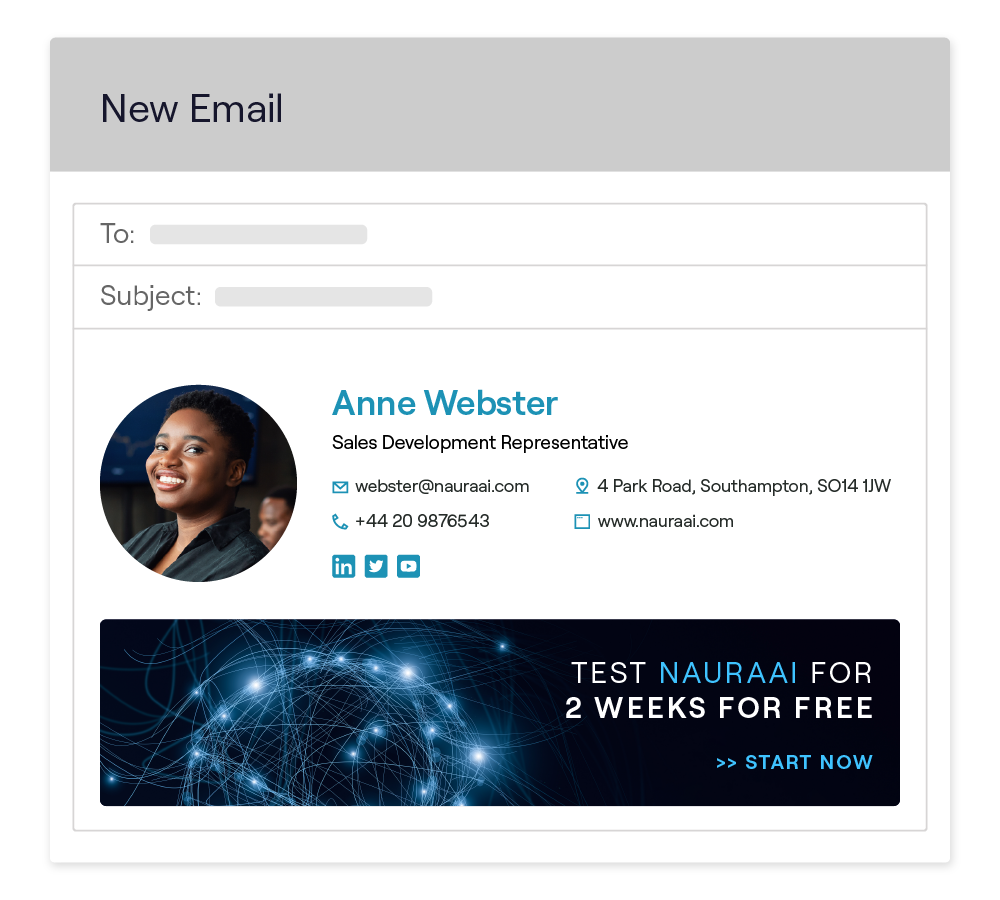
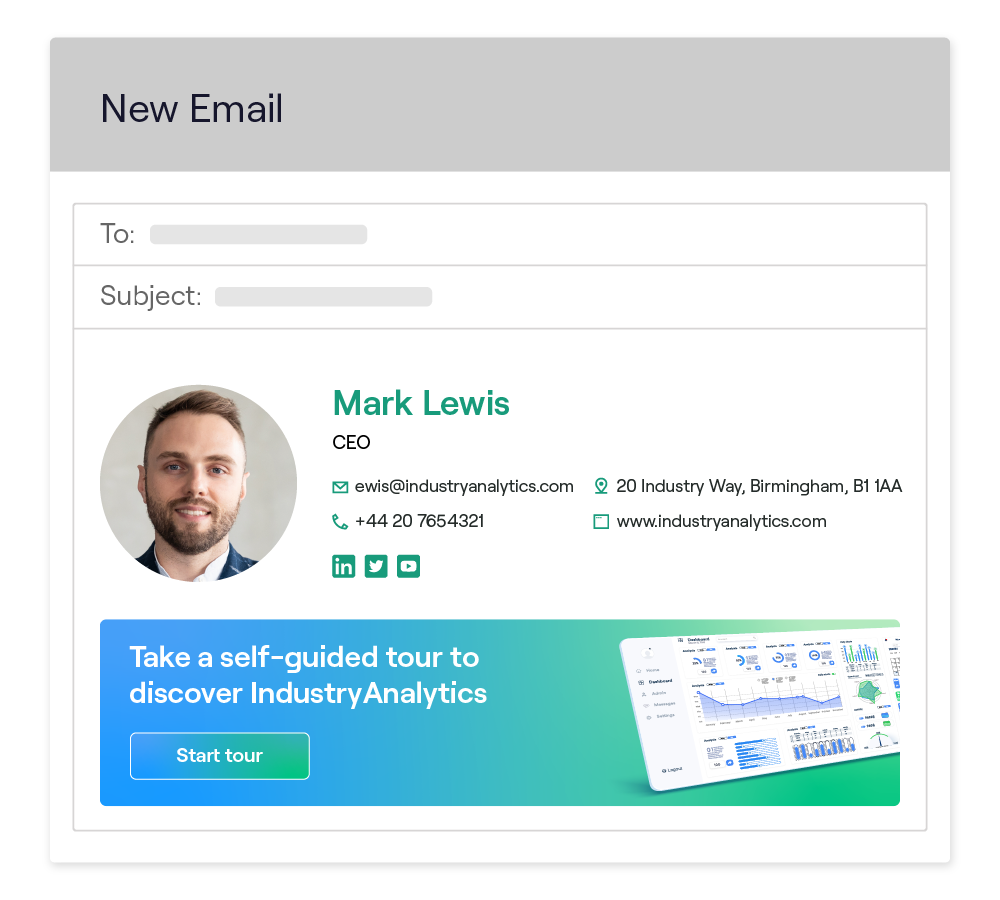
Chapter 6 - How to effectively implement ABM campaigns with signature banners
Targeted and individual messages sent at the right time - that sounds like every marketer's dream. After all, who wouldn't prefer to be informed about relevant events, promotions, or other content instead of receiving another generic promotional email?
With Account-Based Marketing (ABM), you can effectively reach your customers and leads. ABM is a marketing strategy where companies align their marketing activities with individual target customers or accounts.
Instead of sending broad messages to a large audience, ABM focuses on creating personalized content tailored to the needs and interests of specific companies or decision-makers. The goal of ABM is to build a closer relationship with key customers and increase the chances of winning new business.
Compared to generic marketing campaigns, ABM primarily convinces with a higher conversion rate. According to a survey, 76% of marketers reported achieving a better ROI through ABM.
In this chapter, we'll show you how Account-Based Marketing works and how signature banners support you in an effective ABM campaign.
Types of Account-Based Marketing
ABM is not one-size-fits-all - although Account-Based Marketing always aims for message personalization, there are strategic differences. ABM can be targeted not only at a specific company but also at larger groups effectively without neglecting the personal touch that characterizes ABM.
1:1 ABM: Personalised marketing for target accounts
This strategy focuses on individually targeting specific customers or a small group of customers. The marketing team creates highly personalized content and activities to build a close relationship with each customer.
1:Few ABM: Targeting based on commonalities
The focus is on a small group of target customers, usually between a handful and a dozen. Smaller groups of accounts with certain commonalities are targeted. Marketing tailors its messages and content to the common characteristics and needs of this selected group.
1:Many ABM: Ideal for larger audiences
This strategy targets a broader audience of customers, often hundreds or thousands. With 1:Many ABM, larger groups are addressed, such as those from the same industry or belonging to a higher-level category. Marketing uses segmentation and targeting to identify similar customer segments and provide relevant content.
Choosing the right ABM strategy depends on various factors, including the size of the customer base, the company's resources, and the complexity of customer relationships.
How to support ABM campaigns with email signatures
As mentioned, ABM is all about personalised marketing - and there is no more personal marketing channel than email. By using a banner that is tailored to the recipient's needs or pain points, you can maximise your ABM strategy.
1:1 ABM with personalised banner campaigns
The focus here is on a highly personalised experience, including email communication. A personalised banner could contain a tailored offer that directly addresses the needs and interests of the target account.
For example, the banner could offer an exclusive discount or customised service. In addition to a personalised subject line in the email, banners featuring the company's name, colours or logo can help make the interaction even more personal.
1: Few ABM banner campaigns based on the buying cycle
Imagine a company that wants to run an ABM campaign to upsell existing customers to an advanced feature or package. Instead of targeting all customers, the company focuses on a group of customers who are potentially suitable for the upsell.
In this campaign, signature banners placed in emails are used. These banners are specifically designed to communicate the added value briefly and succinctly. For example, the banner could highlight how the additional feature or package could improve the customers' workflows or what additional benefits it offers.
Moreover, the campaign can include an exclusive offer to increase the incentive. This offer could include discounts, free trial periods, or other special conditions available only to the selected group of customers.
1: Many ABM banner campaigns based on geographic location
1:Many ABM approaches can be used to deliver personalised campaigns on a larger scale. This is particularly useful when the location of the target audience is relevant, for example at an event or trade show. Again, banners can be used strategically.
If a recipient is based in a specific region, marketers can promote targeted offers or events in that region to increase the relevance of the signature banner and boost engagement. Especially with 1:Many ABM, larger audiences can be addressed quickly and personally.
1: Many banner campaigns based on industries
Another effective approach for 1:Many ABM is using signature banners reflecting references from specific industries of the target accounts. Customer reviews and testimonials continue to play a crucial role in the buyer's decision-making process.
For example, marketers can use quotes or testimonials from satisfied customers to strengthen the trust and credibility of their brand. With an ABM approach, you can use appropriate testimonials from a specific industry and segment your audience by the corresponding industry.
By incorporating reviews, awards, and customer testimonials, you can persuade recipients and convert leads into customers.
Dynamic banners based on behavioural data
Thanks to pixels and tracking, we can track user behaviour in great detail. So why not use this data to integrate dynamic offers into emails?
Marketers can use signature banners containing dynamic content based on the recipient's previous interactions with the brand. A simple example would be promoting products or services that the recipient recently viewed on the company's website.
By highlighting relevant products or services in the signature banner, marketers can increase the likelihood of the recipient clicking on it and triggering further interactions.
CRM data as the basis for automated ABM campaigns
Many companies already use CRM tools to manage leads, existing customers, and other target groups in one central place. So why not use this data to create personalized ABM campaigns that always address your target audience exactly right?
Tools like HubSpot allow you to segment leads based on buying behaviour, demographics or other factors. Segmented groups are the ideal basis for creating highly optimised marketing campaigns.
Mailtastic offers seamless integration with popular CRM solutions like HubSpot, Marketo, or Pardot. Through a simple connection, you can track all interactions at any time, from lead generation to personalized email.
Account-based marketing: Tailored targeting
For marketers, Account-Based Marketing is an essential tool that always addresses target groups and individuals individually. Through campaigns tailored precisely to pain points, local events, or desired services, you achieve targeted targeting. In short, with thoughtful ABM, you leave no questions unanswered.
Email signatures can do much more than just display your contact information.
Chapter 7 - Outro
At the end of this eBook, let's review: Personalised marketing is not just a trend, it's the future of advertising. With a personalised channel and personalised marketing messages, advertising no longer feels like a blunt sales pitch.
In this eBook, we've explored the transition from traditional mass advertising to personalised communication. We've found out how advertising can work effectively today. The key is the right mix of channel, timing and content.
In particular, we've focused on the use of email signatures as a personalised advertising channel. The eye-tracking studies and expert interviews presented have shown how effective and unobtrusive banners in email signatures can be. This sets marketers apart from traditional mass advertising.
It is also an easy strategy for marketers to implement and increases reach. There are many ways to personalise and use email signatures to suit your marketing campaigns. Try it out and start small, perhaps with a signature banner for an upcoming event, and monitor the impact on your marketing goals.
We hope you find the tips, interviews and case studies inspiring for your own marketing strategies.
Read how other marketing teams use signature banners


